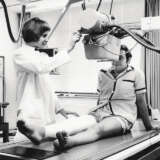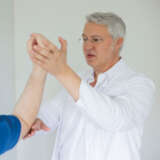3 questions for Chief Physician Dr. Markus Leyh on the treatment and surgery of cruciate ligament ruptures in professional sports
Photo: Sportklinik Hellersen
Have article read aloud
In professional sports, there are clear standards for certain injuries, such as cruciate ligament ruptures. Why is it necessary to treat this injury and, if necessary, operate within 24 hours?
Dr. Markus Leyh: A professional athlete will always strive to return to their passion or profession as quickly as possible. In this context, surgery can be performed immediately within the first four days or the first week of injury. Rapid diagnosis therefore allows a very early response to the injury. In addition, rapid detection of a cruciate ligament injury is important in order to immediately initiate rehabilitative measures for competitive athletes so that as little muscle, fitness, and coordination as possible is lost. Without a correct diagnosis, secondary injuries to the cartilage and menisci are possible. These make further treatment of the cruciate ligament injury more difficult.
What are the medical risks if this requirement is not met?
Dr. Markus Leyh: At the Sportklinik Hellersen, we operate either on a freshly injured knee or once the inflammation has subsided in the joint – for example, after six weeks. We require that the joint to be operated on has free mobility and that the inflammation of the joint lining, capsule, and tendons has subsided. However, the data on this is heterogeneous. Some clinics or surgeons say that cruciate ligament replacement can be performed at any time. Other studies, however, show that surgery in this intermediate interval – for example, after three weeks – increases the risk of partial stiffness (arthrofibrosis) and leads to a prolonged healing process.
For which other injuries is such rapid action also essential?
Dr. Markus Leyh: In my opinion, knee injuries should always be diagnosed promptly, as cruciate ligament injuries are often accompanied by injuries to the collateral ligaments, cartilage, or menisci. These must be treated at an early stage. We now have a large number of MRI machines available. An undiagnosed collateral ligament injury, for example, leads to a significantly longer healing time or even the need for secondary collateral ligament reconstruction. Permanent instability or secondary injuries are also possible and can ruin the goal of returning to the previous level of performance. MRI images allow us to decide whether and when surgery is necessary or to what extent this injury can be treated conservatively. Posterior cruciate ligament injuries or complex cartilage injuries can also be detected. Complicated meniscus tears such as root tears or bucket-handle meniscus tears must be treated quickly with surgery, as otherwise there is a risk of significant consequential damage and a protracted recovery process. This applies to all patients, but especially to professional athletes. We therefore strive to diagnose and treat injured knee joints as quickly as possible.
















